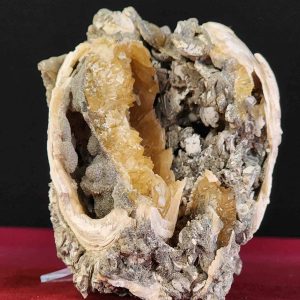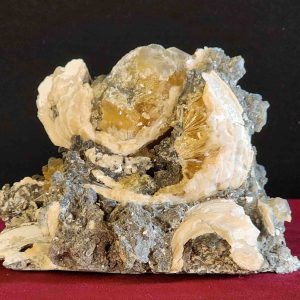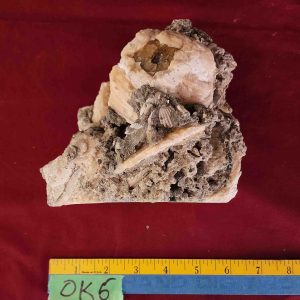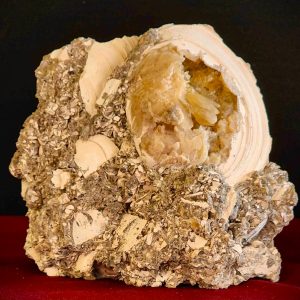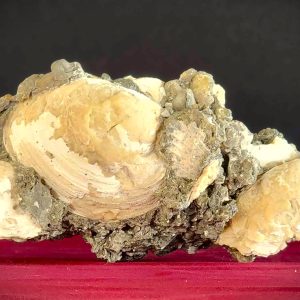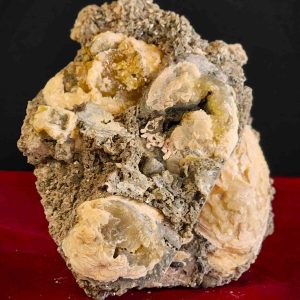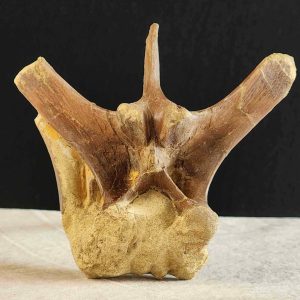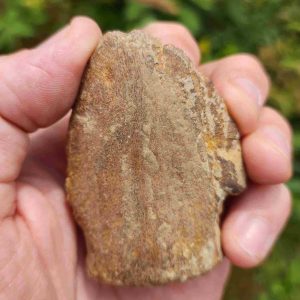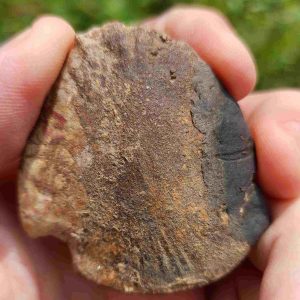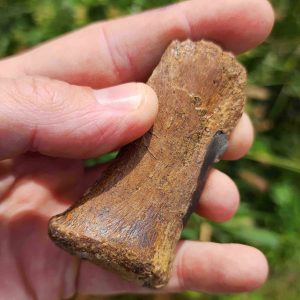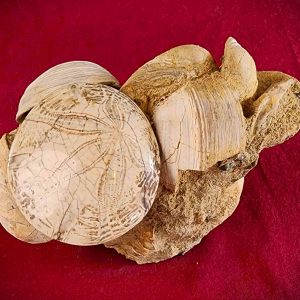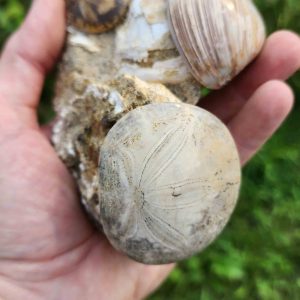- The product "St Clair Flora - Rare preservation (F1)" has been removed from your wishlist because it can no longer be purchased.
- Failed to add “St Clair Flora - Rare preservation (F1)” to your wishlist
-
Crystalized Clam (OK4)
Crystalized fossil clams like this are exceptionally rare. These clams lived in a shallow sea that covered most of Florida 2 million years ago. A sudden storm event buried the clams, trapping cavities inside. When the shells began to dissolve, it provided the material necessary to grow calcite crystals in the open spaces. These unusual fossils are known from only one site, an old quarry near Lake Okeechobee. The quarry played out and flooded in 2007. We excavated this in 2023. An attractive and informative display card accompanies the specimen.
Notes specific to this specimen: Double hollow with great dogtooth calcite crystals replacing this clamshell. In matrix.
SIZE: 6″x 4″x 5″
NAME: Mercenaria permagna
AGE: Pleistocene 2 million years
UNIT: Nashua Formation
SITE: Okeechobee County, FloridaDocumentation: This authentic fossil specimen comes with a Certificate of Authenticity and Origin.
$380.00Crystalized Clam (OK4)
$380.00 -
Crystalized Clam (OK5)
Crystalized fossil clams like this are exceptionally rare. These clams lived in a shallow sea that covered most of Florida 2 million years ago. A sudden storm event buried the clams, trapping cavities inside. When the shells began to dissolve, it provided the material necessary to grow calcite crystals in the open spaces. These unusual fossils are known from only one site, an old quarry near Lake Okeechobee. The quarry played out and flooded in 2007. We excavated this in 2023. An attractive and informative display card accompanies the specimen.
Notes specific to this specimen: Great honey calcite crystals replacing multiple clam shells trapped in matrix. Some excellent radial calcite crystals here as well. This piece has a sawn flat bottom so it stands up nicely on its own
SIZE: 7″x 5″x 5″
NAME: Mercenaria permagna
AGE: Pleistocene 2 million years
UNIT: Nashua Formation
SITE: Okeechobee County, FloridaDocumentation: This authentic fossil specimen comes with a Certificate of Authenticity and Origin.
$380.00Crystalized Clam (OK5)
$380.00 -
Crystalized Clam (OK6)
Crystalized fossil clams like this are exceptionally rare. These clams lived in a shallow sea that covered most of Florida 2 million years ago. A sudden storm event buried the clams, trapping cavities inside. When the shells began to dissolve, it provided the material necessary to grow calcite crystals in the open spaces. These unusual fossils are known from only one site, an old quarry near Lake Okeechobee. The quarry played out and flooded in 2007. We excavated this in 2023. An attractive and informative display card accompanies the specimen.
Notes specific to this specimen: Great honey calcite crystals replacing multiple clam shells trapped in matrix. Some excellent radial calcite crystals here as well. This piece has a sawn flat bottom so it stands up nicely on its own
SIZE: 7″x 4″x 5″
NAME: Mercenaria permagna
AGE: Pleistocene 2 million years
UNIT: Nashua Formation
SITE: Okeechobee County, FloridaDocumentation: This authentic fossil specimen comes with a Certificate of Authenticity and Origin.
$440.00Crystalized Clam (OK6)
$440.00 -
Crystalized Clam (OK7)
Crystalized fossil clams like this are exceptionally rare. These clams lived in a shallow sea that covered most of Florida 2 million years ago. A sudden storm event buried the clams, trapping cavities inside. When the shells began to dissolve, it provided the material necessary to grow calcite crystals in the open spaces. These unusual fossils are known from only one site, an old quarry near Lake Okeechobee. The quarry played out and flooded in 2007. We excavated this in 2023. An attractive and informative display card accompanies the specimen.
Notes specific to this specimen: Great honey calcite crystals replacing multiple clam shells trapped in matrix. Some excellent radial calcite crystals here as well. This piece has a sawn flat bottom so it stands up nicely on its own
SIZE: 7″x 5″x 7″
NAME: Mercenaria permagna
AGE: Pleistocene 2 million years
UNIT: Nashua Formation
SITE: Okeechobee County, FloridaDocumentation: This authentic fossil specimen comes with a Certificate of Authenticity and Origin.
$525.00Crystalized Clam (OK7)
$525.00 -
Crystalized Clam (OK8)
Crystalized fossil clams like this are exceptionally rare. These clams lived in a shallow sea that covered most of Florida 2 million years ago. A sudden storm event buried the clams, trapping cavities inside. When the shells began to dissolve, it provided the material necessary to grow calcite crystals in the open spaces. These unusual fossils are known from only one site, an old quarry near Lake Okeechobee. The quarry played out and flooded in 2007. We excavated this in 2023. An attractive and informative display card accompanies the specimen.
Notes specific to this specimen: Calcite replacing multiple clam shells trapped in matrix, some with clearly defined crystals. One of these is a full clam with crystal zones evident.
SIZE: 11″x 5″x 5″
NAME: Mercenaria permagna
AGE: Pleistocene 2 million years
UNIT: Nashua Formation
SITE: Okeechobee County, FloridaDocumentation: This authentic fossil specimen comes with a Certificate of Authenticity and Origin.
$420.00Crystalized Clam (OK8)
$420.00 -
Crystalized Clam (OK9)
Crystalized fossil clams like this are exceptionally rare. These clams lived in a shallow sea that covered most of Florida 2 million years ago. A sudden storm event buried the clams, trapping cavities inside. When the shells began to dissolve, it provided the material necessary to grow calcite crystals in the open spaces. These unusual fossils are known from only one site, an old quarry near Lake Okeechobee. The quarry played out and flooded in 2007. We excavated this in 2023. An attractive and informative display card accompanies the specimen.
Notes specific to this specimen: Stunning piece! Great honey calcite crystals replacing multiple clam shells trapped in matrix. Some excellent radial calcite crystals here as well. This piece has a sawn flat bottom so it stands up nicely on its own.
SIZE: 9″x 6″x 6″
NAME: Mercenaria permagna
AGE: Pleistocene 2 million years
UNIT: Nashua Formation
SITE: Okeechobee County, FloridaDocumentation: This authentic fossil specimen comes with a Certificate of Authenticity and Origin.
$220.00Crystalized Clam (OK9)
$220.00 -
Dinosaur Bones (D1)
Notes specific to this specimen: This is a very well preserved neural arch and process of a cervical vertebrae, probably about midway down the neck of a hadrosaur (bipedal) dinosaur. The centrum is not present. The fine detail on the bone surface is exquisite and remarkably well preserved. This exceptional piece has no reconstruction.
SIZE: 5″ x 5″ x 3″
NAME: Edmontosaurus
AGE: Cretaceous Period – 68 million years
UNIT: Lance Creek Formation
SITE: Lance Creek, Wyoming
Location: Blue Crate
DATE: 1992Documentation: This authentic fossil specimen comes with a Certificate of Authenticity and Origin.
$820.00Dinosaur Bones (D1)
$820.00 -
Dinosaur Bones (D2)
Notes specific to this specimen: Commonly called the “hoof” of a hadrosaur – in this case Edmontosaurus – this is the end bone of a pes digit (toe). In vertebrates, the ends of the front appendages are called the “manus” (aka hand) while the back are called the “pes” (aka foot). The asymmetry here indicates this was likely a toe on the right side of the animal. The fine detail on the bone surface is exquisite and remarkably well preserved. This piece has no reconstruction.
SIZE: 3″ x 2″ x 1″
NAME: Edmontosaurus
AGE: Cretaceous Period – 68 million years
UNIT: Lance Creek Formation
SITE: Lance Creek, Wyoming
Location: Blue Crate
DATE: 1992Documentation: This authentic fossil specimen comes with a Certificate of Authenticity and Origin.
$575.00Dinosaur Bones (D2)
$575.00 -
Dinosaur Bones (D3)
Notes specific to this specimen: Commonly called the “hoof” of a hadrosaur – in this case Edmontosaurus – this is the end bone of a pes digit (toe). In vertebrates, the ends of the front appendages are called the “manus” (aka hand) while the back are called the “pes” (aka foot). The fine detail on the bone surface is remarkably well preserved. This piece has a small amount of reconstruction as shown in the dark paleoclay area.
SIZE: 3″ x 2″ x 3″
NAME: Edmontosaurus
AGE: Cretaceous Period – 68 million years
UNIT: Lance Creek Formation
SITE: Lance Creek, Wyoming
Location: Blue Crate
DATE: 1992Documentation: This authentic fossil specimen comes with a Certificate of Authenticity and Origin.
$420.00Dinosaur Bones (D3)
$420.00 -
Dinosaur Bones (D4)
Notes specific to this specimen: This is a distal manus digit (“finger”) bone of Edmontosaurus. In vertebrates, the ends of the front appendages are called the “manus” (aka hand) while the back are called the “pes” (aka foot). The fine detail on the bone surface is remarkably well preserved. This piece has a small amount of reconstruction as shown in the dark paleoclay area.
SIZE: 3″ x 1″ x 1″
NAME: Edmontosaurus
AGE: Cretaceous Period – 68 million years
UNIT: Lance Creek Formation
SITE: Lance Creek, Wyoming
Location: Blue Crate
DATE: 1992Documentation: This authentic fossil specimen comes with a Certificate of Authenticity and Origin.
$365.00Dinosaur Bones (D4)
$365.00 -
Fossil Sand Dollar and Clam (KH1)
These well-preserved clams and sand dollars lived in a shallow sea that covered the San Joaquin Valley for millions of years. During storms the animals became buried in sediments which preserved the shells. Under heat and pressure, the shells altered into calcite, yet preserved their fine detail. Later, due to movement of the nearby San Andreas fault, the whole area was uplifted, becoming the Kettleman Hills. The Hills became famous for its oil in the 1920s. But the oil has since played out and the land is returning to its former native environment. We’ve polished the primary shells to show their beauty and detail. Iron and petroleum color the shells. We have spent years mapping the Hills and are the only people who know where to find these unique fossils.
NOTE: One superb large sand dollar and several clams. An attractive and informative display card accompanies the specimen.
SIZE: 6″x 3″x 4″
* Shipping includes packaging, insurance, and ground transport in the continental US. Inquire about shipping outside US.
$84.00 -
Fossil Sand Dollar and Clam (KH2)
These well-preserved clams and sand dollars lived in a shallow sea that covered the San Joaquin Valley for millions of years. During storms the animals became buried in sediments which preserved the shells. Under heat and pressure, the shells altered into calcite, yet preserved their fine detail. Later, due to movement of the nearby San Andreas fault, the whole area was uplifted, becoming the Kettleman Hills. The Hills became famous for its oil in the 1920s. But the oil has since played out and the land is returning to its former native environment. We’ve polished the primary shells to show their beauty and detail. Iron and petroleum color the shells. We have spent years mapping the Hills and are the only people who know where to find these unique fossils.
Notes specific to this specimen: Matrix piece that has a flat bottom so it stands nicely. This specimen has one large and one infant sand dollar with a nice polished clam that has great colors.
SIZE: 5″x 3″x 3″
NAME: Psuedocardium & Dendraster
AGE: Pliocene Epoch – 4 million years
UNIT: Etchegoin Formation
SITE: Kettleman Hills, California
DATE: 2023Documents: This authentic fossil specimen comes with a Certificate of Authenticity and Origin. In addition, an attractive and informative display card accompanies the specimen.
$460.00

